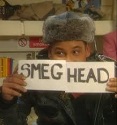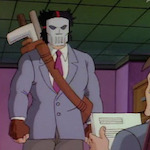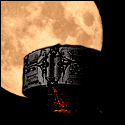|
Kai Tave posted:Is there any actual benefit to confirming crits that I'm unaware of besides "critical hits are less common now?" Suspense? Also, the easier crits are the more it favors monsters. A player critting for 3-4x average damage is likely overkill. A monster critting is often a KO.
|
|
|
|

|
| # ? May 28, 2024 04:03 |
|
Tunicate posted:Stacks of advantage and disadvantage cancel. That's about it. What do you mean? If you have 2 sources of advantage, and one source of disadvantage, the dice roll is made normally (read, one d20 rolled, take the result), same as 1 of each, 20 of each, or 20 of one and 1 of another.
|
|
|
|
I need a name for my wild mage
|
|
|
|
bowmore posted:I need a name for my wild mage Maggie Wilder.
|
|
|
|
PJOmega posted:Suspense? You get this on every roll though. quote:Also, the easier crits are the more it favors monsters. A player critting for 3-4x average damage is likely overkill. A monster critting is often a KO. This is something that would have been, and has been, easily solved by either having crits work differently for monsters than they do for player-characters or simply making sure that the math doesn't lead to a random level 2 orc potentially splattering a full-HP character across the walls like jam. Basically it's really fuckin stupid to say that the reason you have to roll to hit and to confirm on a crit is because it's to protect you from the system inadvertently brutalizing you too much.
|
|
|
|
Kai Tave posted:Is there any actual benefit to confirming crits that I'm unaware of besides "critical hits are less common now?" Like I said, it makes it so that crits are per hit and not per attack. In the late stages of AD&D2, this was actually a Whole Big Thing. At the extreme ends, you had poo poo where goblins could only hit the party with natural 20s, so every single attack they did was a critical hit. On the flip side, you get people with super low THAC0s that basically never miss, but few of their hits are crits, and it's just counterintuitive and weird for the less skilled combatants to have a higher crit percentage. The Combat and Tactics book tried to come up with ways to fix this, with the "simplest" being that an attack had to be a natural 18-20 AND succeed by at least 5 in order to qualify as a crit. And, being the experimental proto 3e book, it slapped on a bunch of charts and caveats and feats and stuff to tweak that. In an early stage of 3e before it was released, crits were determined a little differently: the attack roll had no bearing on if you crit or not, but every time you hit you roll another die; if you roll within the threat range (usually 19-20) on the second roll, you upgrade the hit to a crit. Obviously, this is a lot of busywork extra rolling, so they flipped the math around to what it came out to be at release. What a lot of people don't realize is that the two versions are mathematically identical. 4e's solution to the same problem was to just try and make sure that the target number to hit is basically always the same, so there's not huge difference in crit chance % from case to case. It wasn't entirely successful at this. Also, the way it makes sure a crit can't do less damage than a regular attack is a nice touch, but irrelevant to this particular problem. 5e also tries to rely on flatter math, but did an even worse job at actually making the math flat. e: crits aren't necessarily less common. In 2e, crits only occur on a natural 20. If you hit about half the time, then about 10% of your hits are crits. In 3e, the default threat range is 19-20, making 10% of your hits crits. Tendales fucked around with this message at 05:59 on May 5, 2016 |
|
|
|
Crit Confirm is stupid and changing the name wouldn't stop it from being loving stupid
|
|
|
|
Tendales posted:Like I said, it makes it so that crits are per hit and not per attack. Who gives a poo poo??? The confirmation dice roll, again, bogs down the game, and adds another barrier to something exciting happening. But on the bright side, something something per hit, not per attack. Sorry chief. Can't see how it's worth it in the slightest.
|
|
|
|
Kai Tave posted:You get this on every roll though. I'm not saying crit confirmations or whatnot are good or something I want, simply answering the question. I agree that having monster attacks crit in an identical manner is dumb. Really, the justification for crit confirmations was likely "well what if a level 1 character gets a vorpal sword how do we stop him from one shotting a balor with a crit? 5% of the time the player will one shot him!" It gives higher AC a marginal crit reducer, and rewards higher attack bonuses (normally gained at cost of raw damage). Which is rendered moot by 3e's modifier treadmill. It's bad, slows the game down, and was really, really dumb to have monsters fight in the same way "for verisimilitude."
|
|
|
|
See, this is exactly my point. Usually goons are so good at looking at the mechanics for what they are, but in this one specific case looking at what the mechanic ACTUALLY does (makes the effects of crits more reliable) instead of what it FEELS like it does (makes crits less likely) tummyfeels win the day. It's honestly fascinating.
|
|
|
|
Tendales posted:what the mechanic ACTUALLY does (makes the effects of crits more reliable) Sorry, I haven't linked up to the hivemind yet today so maybe you can try to explain to me how the mechanic of rolling 20 once and then rolling against a DC makes crits more reliable than rolling 20 once? I'm probably just misunderstanding something.
|
|
|
|
Generic Octopus posted:Sorry, I haven't linked up to the hivemind yet today so maybe you can try to explain to me how the mechanic of rolling 20 once and then rolling against a DC makes crits more reliable than rolling 20 once? I'm probably just misunderstanding something. When crits are per hit, then the expected amount of damage they do is a fixed percentage. If a crit does double damage, and you crit 10% of the time, then your expected damage per hit is 10% more than just your listed damage. On the other hand, if your crits are per attack, then the amount of damage they do is a variable percentage. If you only hit on a 19-20 but you also crit on a 19-20, then your damage per hit is twice your listed damage. If you hit on a 11-20 and crit on 19-20, then your damage per hit is 20% more than your listed damage. The average damage a crit does per hit changes based on your accuracy, and it actually goes down as you get more accurate. All of this would matter more if the designers of 3e had actually paid attention to any of this math in their monster design but 
|
|
|
|
Ran my first session ever tonight. Got some guff early on from a couple players for having them make too many skill checks, but after gently reminding them that I had no part in their choosing to play as rock gnomes, and that maybe trying to brute strength every situation when you're only two feet tall isn't such a great idea, they fell into their roles and started thinking more like tinkerers and schemers. After we were done, everyone kept congratulating each other over breaking out of the suspended cage they'd woken up in and how it'll never be able to hold anyone or anything again after what they did to it. The look on their faces next session when they realize that every time they take a long rest they wake back up in the cage, perfectly intact, and nobody they've encountered thus far has any memory of who they are or what they've done should be priceless.
|
|
|
|
Tendales posted:When crits are per hit, then the expected amount of damage they do is a fixed percentage. If a crit does double damage, and you crit 10% of the time, then your expected damage per hit is 10% more than just your listed damage. There's a lot to unpack here. First of all this only matters when dealing with monsters. Having your damage be 'twice' your 'listed damage' is only important insofar as a monster's entry can be deceptive if it only ever strikes on a crit. This is already a problem for monsters because they roll more than players. Solution: don't let monsters get double damage. Give them a 'crit damage' stat. Derive it any way you want to, it doesn't matter. For players, none of that matters. Also, just because a monster only hits on a crit and therefore does double damage when he does, consider that, overall, he's only hitting 5% (5e) or 10% (3e) of the time. Assuming we live in a world where crits don't exist for a moment - a monster that deals 10 damage, hits 5% of the time, their average, effective damage is (10*.05) or about 1/2 a point of damage per round. You can't gloss over the fact that the monster is going to miss something like 90 or 95% of the time. Why does it even matter that if the monster hits, he's going to crit?
|
|
|
|
I think you should roll a d20 to see if you hit, and if you get a 20 then you roll a second d20 and if you roll less than 10 - your strength mod then you can't crit and if you roll over that then you can crit, then you roll a d20 to see if you crit (result depends on your weapon) and then another d20 and if it's 1-5 your damage dice are rolled again on their maximum number, if it's 6-15 your damage dice are rolled again on their maximum number -1 and if it's 16-20 then your damage dice are rolled again on their maximum number -2 and for each damage dice maxed out on the second roll you get an extra +1 on your "do you crit" (the weapon dependant one not the "can you crit" one) d20 next time you might be able to crit. If you have advantage while all this is going on then ask your DM what happens. I'm sure the goon hivemind will think this is stupid though.
|
|
|
|
Crits are fun and making them more complicated just adds busy work.
|
|
|
|
Okay, history lesson time: D&D did not have critical hits for a long time. Gygax was openly against it, including one issue of Dragon Magazine where someone writes in "here's a d100 critical hit table I wanted to share!" and he gets tetchy and writes back "well how about this critical hit table: roll d100, on a 1 to 100 you die", or something to that effect. And there was, of course, a number of third-party critical hit ideas, with Arduin and Rolemaster being the more well-known ones. AD&D 2nd Edition finally made an official critical hit system with Combat & Tactics. The key thing to their critical hit system was that it was triggered by "if you roll a nat 18, 19 or 20, and you exceed your required to-hit roll by 3". That second clause was necessary because if you could only hit a monster on a to-hit roll of 20, but a nat 20 triggers crits, then every hit is also automatically a crit, which is bad from a verisimilitude and "neatness of mechanics" perspective That's why 3rd Edition has crit confirmations: the target has AC 21, and you're only rolling a flat d20 to attack. You get a nat 20, you get a critical threat, but since you can never hit AC 21, the crit will never confirm and nat 20s will only ever produce automatic hits. The fact that they made it into an entire separate roll was because they wanted to add more moving parts to the mechanic. An spell/ability/class feature that gives you a bonus on crit confirmations. Weapons that have a wider crit threat and a 2x modifier versus weapons that have a 20-only crit threat but a 3x modifier, that sort of thing. Of course, we know from hindsight that the math was never really rigorous enough for all of these spinning plates to be worth their various trade-offs, but that was at least the idea. We get to 4th Edition and the crit system is refined even further: if you roll a nat 20 and the 20 is good enough for a normal hit, it's also a crit. It's as neat as the 2nd Edition implementation where you don't need to roll twice, but you're still preventing the AC 21 target from getting crit all the time. And then finally we get to 5th Edition and it throws out the baby with the bathwater: if you roll a nat 20, you crit. Simple, except it's even less developed than the original 2nd Edition implementation since it's now running into that same "all hits are crits" problem that Combat & Tactics was trying to avoid in the first place! I'm not outright defending crit confirmations as a good idea, and I agree that it's additional overhead at the table, but there was a very specific (and arguably sensible) reason why it was done.
|
|
|
|
The problem is that making an extra step of rolling for a critical effect ends up being cumbersome in play. If you're rolling to hit, then rolling to crit, and then rolling for damage; you've got three separate steps to process every time someone makes an attack. It won't be isomorphic, but stripping out as many of these steps as feasible works wonders for making combat streamlined. As an example of this, oWoD* attacks had the attacker roll an attack pool against a defense pool, and if they won then they'd roll a damage pool (with additional dice equal to extra attack successes, I think?) against a soak pool. (My group is mostly using this right now and I can assure you that it's kinda slow.) But over the years they streamlined things considerably. In GMC/CoD** (the newest rules variant), the attacker rolls their attack pool with a defense penalty already baked in, and then adds their successes to (weapon bonus - armor) to get a damage value. Just making one roll is a lot simpler and faster in play, especially when the person using those new rules has a weapon that can hit from anywhere on the drat map. This is in addition to 3E's mechanism of confirming crits (which, as above, is "adding a new dice roll to ensure something exciting doesn't happen"), which as noted was likely made to combat the issue that some monsters would have such terrible chances of hitting that they would either miss or crit. But that wasn't an issue with the critical mechanism; rather, it was a problem with critters who were both forced off one side of the RNG and required to use the same rules as PCs. I understand that often the latter is a very useful tool for keeping things straight, but as a number of games have shown since at least Feng Shui (which had a designation for mooks or somesuch) enemies whose purpose is to be stomped don't deserve to use the full ruleset. But in any case, the former problem that things can be forced off the end of the RNG without stepping back for examination is the greater issue. If you've got a bunch of goblins against the PCs who can't hit except on a natural 20...why are the PCs facing them in the first place? What's wrong with declaring that the PCs mop them up handily? Or if the game intends for some sort of OSR-style resource-tracking play, why not have a mechanism for the goblins (or anything else that's individually useless) to bunch up in some sort of mob where they're an appreciable threat? @ Tendales: Why are you concerned about damage-per-hit rather than damage-per-attack? Sure, by the one-roll-to-attack-and-crit model your average damage-per-hit goes down as your accuracy goes up. But keep in mind that damage-per-hit is predicated on the outcome that you actually hit. If you miss...then your damage-per-hit is zero. (Unless you have damage-on-a-miss, of course.) And as is obvious, if your accuracy goes up then your damage-per-attack also goes up because more faces on the d20 will lead to actual damage on the attack. In a nutshell, you're getting too concerned about conditional values when you should be concerned about more general ones. *Old World of Darkness rules. **God-Machine Chronicle/Chronicles of Darkness.
|
|
|
|
NGDBSS posted:as a number of games have shown since at least Feng Shui (which had a designation for mooks or somesuch) enemies whose purpose is to be stomped don't deserve to use the full ruleset. But in any case, the former problem that things can be forced off the end of the RNG without stepping back for examination is the greater issue. If you've got a bunch of goblins against the PCs who can't hit except on a natural 20...why are the PCs facing them in the first place? What's wrong with declaring that the PCs mop them up handily? Or if the game intends for some sort of OSR-style resource-tracking play, why not have a mechanism for the goblins (or anything else that's individually useless) to bunch up in some sort of mob where they're an appreciable threat? Now that you mention it, there's a Feng Shui adventure I came across that's dual-statted for F20 games, and one of the variant rules is Minions that shrug off damage less than 5, but are immediately killed upon taking more than 5 damage, and they only ever hit on natural 18, 19, 20 but otherwise don't even have a defined attack roll bonus.
|
|
|
|
I guess I'm still confused why it matters that sometimes an orc will only ever hit if he crits. If you've reached a point where you've trivialized Gary the Orc, then him doing double damage isn't going to matter a whole hell of a lot either. Gary can only hit your Fighter if he crits; fair enough, he can only hope to hurt you if he stabs you directly in the eyeball. That's the narrative we've established. So why is that bad? And please, gods, don't say 'because the orc's actual damage is twice his listed damage' because that's not actually a reason either. EDIT: Conversely, it shouldn't matter for the players, either. Sometimes your arrow actually pierces the dragon's scales, even if it shouldn't.
|
|
|
|
Tendales posted:See, this is exactly my point. Usually goons are so good at looking at the mechanics for what they are, but in this one specific case looking at what the mechanic ACTUALLY does (makes the effects of crits more reliable) instead of what it FEELS like it does (makes crits less likely) tummyfeels win the day. It's honestly fascinating. e: because I don't feeeeeel like being probated today, nobody cares about the frequency of the critical hits, it's because the "more difficult" "accomplishment" (hitting the range) comes first, so you already feeeeeel like you've "earned" the crit so if you don't confirm then it feeeeeels like it's been "taken away". Nobody (worth listening to) has ever said incorporating basic human psychology doesn't matter in a hobby designed to make playing an elf fun. Splicer fucked around with this message at 08:22 on May 5, 2016 |
|
|
|
Mendrian posted:I guess I'm still confused why it matters that sometimes an orc will only ever hit if he crits. If you've reached a point where you've trivialized Gary the Orc, then him doing double damage isn't going to matter a whole hell of a lot either. Gary can only hit your Fighter if he crits; fair enough, he can only hope to hurt you if he stabs you directly in the eyeball. That's the narrative we've established. FWIW I don't think it's so bad an oddity that you have to make your crit system as complicated as 3rd Edition's just to fix it. But I do think that it's still possible to fix it (assuming you think it needs to be fixed) without adding the overhead of an extra roll: "it's only a crit, if the roll that triggered it would have been a normal hit as well"
|
|
|
NGDBSS posted:As an example of this, oWoD* attacks had the attacker roll an attack pool against a defense pool, and if they won then they'd roll a damage pool (with additional dice equal to extra attack successes, I think?) against a soak pool. That brings me back. When I was in college we had a Werewolf game, and the GM got ambitious1 and we ended up in "The Siege of Castle Silverfang" where our pack, a pack of allied Silverfangs, and some human retainers defended a castle in France under siege by vampires, Black Spiral Dancers, some summoned elementals, and like two hundred skeletons. It literally took us 25 hours straight to fight that one battle. Ah college, the time when you get to do insane bullshit that would kill you dead in later years. 1 = Literally all the best and worst gaming experiences of my life have begun with the phrase "So the GM got ambitious and..."
|
|
|
|
|
Tendales posted:When crits are per hit, then the expected amount of damage they do is a fixed percentage. If a crit does double damage, and you crit 10% of the time, then your expected damage per hit is 10% more than just your listed damage. Re. the bolded part: I've always found this to be a bunk argument despite it being technically true. It's not a meaningful observation, it's just a quirk of the math, like how a brand new M:tG player who wins their first match is technically undefeated, and their Win:Loss ratio is going to get profoundly worse the more games they play. The big reason why it's a quirk and not meaningful is because there isn't/shouldn't be anywhere in the game where this is the default, universal interaction. You shouldn't really have a space where a level-appropriate monster shows up and can only hit any given party member on a 20.
|
|
|
|
gradenko_2000 posted:But I do think that it's still possible to fix it (assuming you think it needs to be fixed) without adding the overhead of an extra roll: "it's only a crit, if the roll that triggered it would have been a normal hit as well" This is the best option, but FFS it's still only needed in 3.X-style math; in 4e or 5e it's loving moot. The start of this whole discussion was "My DM houseruled in crit confirmations to our 5e game" thus showing that they don't understand the differences between 5e and 3.5 
|
|
|
|
jng2058 posted:Try being non-confrontational and try to correct him in private. Admiral Joeslop posted:I am irrationally angry at people
|
|
|
|
gradenko_2000 posted:AD&D 2nd Edition finally made an official critical hit system with Combat & Tactics. The key thing to their critical hit system was that it was triggered by "if you roll a nat 18, 19 or 20, and you exceed your required to-hit roll by 3". If monsters hitting too many crits is an issue, make them "confirm" somehow but dont require the players to do it. You can even play up the danger of "levelled" enemies by allowing NPC/monsters to crit like a player whereas a giant rat cannot.
|
|
|
|
P.d0t posted:The start of this whole discussion was "My DM houseruled in crit confirmations to our 5e game" thus showing that they don't understand the differences between 5e and 3.5 It was worse than that: Admiral Joeslop posted:that crits have to be confirmed with a second natural 20 to be an actual crit. Ie. 1 in 20 is too often to do marginally more damage, 1 in 400 sounds right.
|
|
|
|
I dislike crits because of how bad it feels when you crit on something that either was about to die to anything or is too small to matter. Not to mention the crits you can roll that do less damage than a max dam roll hit. Hero points or whatever you want to call it is so much better because you actually get to decide when you need to hit harder instead of arbitrarily dealing slightly more damage. At 1 in 400, it might as well be a save or die or something reasonably powerful.
|
|
|
|
Babylon Astronaut posted:I dislike crits because of how bad it feels when you crit on something that either was about to die to anything or is too small to matter. Not to mention the crits you can roll that do less damage than a max dam roll hit. Hero points or whatever you want to call it is so much better because you actually get to decide when you need to hit harder instead of arbitrarily dealing slightly more damage. At 1 in 400, it might as well be a save or die or something reasonably powerful.
|
|
|
|
The way I would do it would be a crit is max damage + whatever you rolled. So you could still roll d20 + damage dice at the same time and it would still work with no additional rolls made.
|
|
|
|
NGDBSS posted:
I'm not, particularly. If anything, it further proves my point. If you have a 100% chance to hit, then you should do twice as much damage over 100 rounds as if you have a 50% chance to hit. With crit on-hit (crit confirms) you do, with crit on-attack (classic style) you don't. Or from the other direction: those lovely goblins that only hit on a 20. Let's say they do 1 damage normally, 2 on a crit. So these goblins are doing 2 damage every 20 rounds. Then their badass buddies come along that only need a 19 to hit. Those goblins do 3 damage every 20 rounds. Common sense tells you that hitting twice as often means they should do twice as much damage, but they don't. They do 50% more damage. See, the point here isn't even that I think crit confirm is good. It's a clumsy fix on a broken system that's better tossed out entirely. But the reaction it gets around here is always as calmly and rationally considered as DOAM is on other sites, and that's hilarious to me. Yes, rolling an extra die once in a while is fiddly and an inelegant extra step, but it's not such an awful burden that it ruins games, and the kneejerk response, even on this Comedy Website The Something Awful Forums, is goofy. Totally down with ability scores delenda est, though. fake edit: xcom2 switched from xcom1's on-hit crit calculation to an on-attack crit calculation and it's dumb and bad and makes the percentages displayed into complete lies and they don't even have the excuse of 'it's an extra die roll'.
|
|
|
|
Tendales posted:See, the point here isn't even that I think crit confirm is good. It's a clumsy fix on a broken system that's better tossed out entirely. But the reaction it gets around here is always as calmly and rationally considered as DOAM is on other sites, and that's hilarious to me. So it's bad and dumb but because people don't think it's bad and dumb for the right reasons something something goon hivemind, gotcha.
|
|
|
|
Another thing we've done is let the player choose crit-by-crit if they want double damage or another attack (against anything within range).
|
|
|
|
Kai Tave posted:So it's bad and dumb but because people don't think it's bad and dumb for the right reasons something something goon hivemind, gotcha. If we poo poo on things just because they're bad and dumb without understanding why, then we wouldn't be able to talk about D&D at all.
|
|
|
|
Tendales posted:If we poo poo on things just because they're bad and dumb without understanding why, then we wouldn't be able to talk about D&D at all. I'm pretty sure everyone here understands that designing a system where you have to roll twice to accomplish the same thing you could just as easily accomplish with a single roll is bad without someone trying to play the Everyone But Me Is So Dumb And Goddam Crazy card in order to get them to do some deep soul searching over it.
|
|
|
|
I mean in 5e most people only crit on a 20, and the widest crit range I know of is 18-20. You're hitting roughly half the time due to the bounded accuracy idea, so the devaluation of to-hit bonuses is small and easily hand-waved. The edge case of a very high 'effective' crit rate doesn't seem relevant in this setup either. Confirming criticals then isn't worth the overhead, and requiring 2 20s in a row is just removing crits from the game. In 3.x you could easily, say, threaten a crit on a roll of 12+ but need 11+ to hit, so confirming criticals is needed to keep attack bonuses from being heavily devalued. No quite sure why a few posters are triggered by this discussion though.
|
|
|
|
Kai Tave posted:I'm pretty sure everyone here understands that designing a system where you have to roll twice to accomplish the same thing you could just as easily accomplish with a single roll is bad without someone trying to play the Everyone But Me Is So Dumb And Goddam Crazy card in order to get them to do some deep soul searching over it. Please stop spraying your tummyfeels into the hivemind, tia.
|
|
|
|
I can't take any of this discussion seriously; using "tummyfeels" in a serious manner, twice even, is so incredibly childish that I now want all crits to be 1-20 range only for monsters so they can crit you every hit no matter what.
|
|
|
|
|

|
| # ? May 28, 2024 04:03 |
|
It doesn't really matter that proportionally more of an inaccurate attacker's hits are crits than of an accurate attacker's. The accurate attacker still does more damage and is more dangerous to fight. Since the books read "crits on a 20" or "crits on a 19+", not "crits 5% of the time" or "crits 10% of the time", there's nothing misleading about just reading the initial attack roll.
|
|
|



































